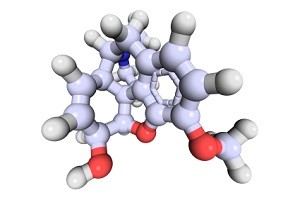Codeine

Brand name(s): Codeine is mixed with other medications such as acetaminophen (Tylenol), aspirin and guaifenesin (cough medicines)
Generic name: Codeine phosphate, codeine sulfate
Preparations: tablet, capsule, liquid (suspension, solution), parenteral [intramuscular (IM) or subcutaneous (SQ)]
Uses for IBS:
Codeine is an opiate agonist, similar to morphine. It is available as a phosphate or sulfate salt, both of which can be administered orally, subcutaneously, or intramuscularly. Compared to morphine, codeine has less analgesic and respiratory depressive side effects, but it is a more effective antitussive agent (or cough suppressant). A 60 mg dose of codeine provides more pain relief, or analgesia, than 600 mg of acetaminophen. The IM and SQ doses are less effective than the oral doses. Codeine is primarily used for relief of pain, cough, and diarrhea.
Codeine acts by binding to opiate receptors and later converting to morphine in the body. They stimulate the mu receptors in the body. This action produces analgesia (pain relief), euphoria, respiratory depression, dilated pupils, decreased gastrointestinal motility, and physical dependence. They also stimulate kappa receptors, which also produces analgesia, dilated pupils, respiratory depression, euphoria and disorientation. Codeine treats diarrhea-predominant IBS by increasing the smooth muscle tone along the GI tract as well as decreasing the secretions of the stomach, pancreas, and biliary tract. The combination of theses effects can result in constipation and delayed digestion.
Contraindications
The FDA, in a Public Health Advisory released in January 2008, recommended that over-the-counter cough and cold products should not be used in infants and children less than 2 years old. For children greater than 2 years old, labels should be carefully read and only measuring devices specifically designed for use with medications should be used.
Codeine can decrease the effects of naltrexone (an opioid antagonist used to treat alcohol or drug abuse), therefore both should not be taken at the same time. Severe interactions can occur if codeine is taken with monoamine oxidase inhibitors (MAOIs-antidepression drugs). Caution should be taken in people taking cimetidine (peptic ulcer drug), quinidine (heart drug), and nalbuphine (opioid for pain relief).
Precautions should be taken in certain groups that can develop adverse effects when taking codeine: infants, children, breast-feeding women, and the elderly.
People with psudeomembranous colitis, respiratory depression, and toxin-mediated diarrhea should not take codeine.
Adverse Effects
Allergic reactions can develop in those sensitive to codeine. The most common side effects are drowsiness and constipation. Other less common side effects include blurry vision, headaches, slowed heart beat, double vision, general weakness, impaired cognition, nausea, vomiting and slowed breathing.
